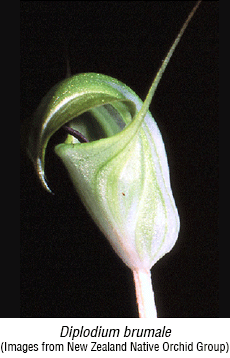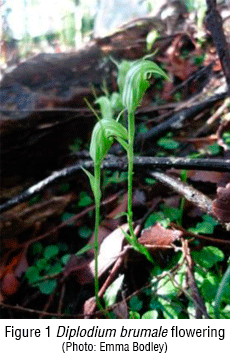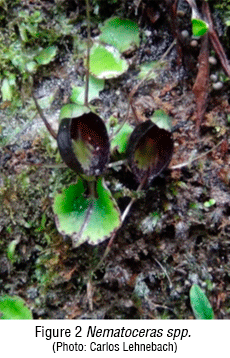<< BACK TO PROJECT LIST
Project: 288/2013
Title: Ecology and pollination of a deceptive New Zealand Greenhood orchid.
Applicant: Emma Bodley
Institution: University of Auckland, New Zealand
In New Zealand there are over 100 species of orchids, of which most are terrestrial plants, and many species have yet to be identified. Pterostylis is one of the dominant orchid groups in New Zealand, and they are commonly known as the greenhood orchids. There are nineteen species of Pterostylis in New Zealand, one of which was renamed in 2007 as Diplodium brumale and this will be the key study species for this research. D. brumale is a native winter-flowering greenhood found in kauri forests and is a sexually deceptive species that fools male insects. D. brumale has a trigger mechanism to trap insect visitors.
I will investigate the phenology, pollination system, and pollinator attractants (e.g. scent glands, colour). I will also assess pollinator identity (by trapping and observations) and spatially map the movement of pollen and its pollinator (using pollen dyes/powders). From this research, a greater understanding of the pollination in species-specific systems such as orchids, and of the phenology of this species will be gained. This research will contribute to broader theory on the evolution of deceptive plant-insect interactions. This will be valuable for future conservation of orchids in fragmented landscapes with the knowledge of pollen dispersal distances.


Project Report
Bodley, E.J., Beggs, J. & Gaskett, A.C.
Orchidaceae is a highly diverse family of plants that have various unusual pollination systems often involving deceit of pollinators and specific pollinator-plant interactions. Our knowledge of New Zealand orchid pollination ecology is limited and there are a large number of orchids that have not been formally characterised. Greenhood (Pterostylis/Diplodium) and spider (Nematoceras) orchids are diverse and highly speciose in New Zealand. Diplodium brumale is a winter flowering greenhood orchid that is thought to deceive male fungus gnats (Mycetophilidae). Nematoceras are spider, or helmet, orchids thought to attract female fungus gnats by brood-site deception. We aimed to understand the pollination systems of both D. brumale and Nematoceras species and varieties orchids.
We documented the phenology, pollination limitations and pollination success of D. brumale. Orchid height was measured and stages of development were recorded during the flowering season. Pollinator exclusion bags were set up with four hand pollination treatments applied to test pollen limitation including self-pollination, cross-pollination, unpollinated and apomixis. The natural population pollination success was monitored during the flowering season. D. brumale requires insect mediated, cross pollination for successful reproductive output, despite its self-compatibility. Naturally, D. brumale showed very low fruit (1-12%) and seed (1-4%) set. Fruit and seed set rates were much higher in hand self and cross pollinated flowers than naturally insect pollinated flowers.
We also investigated the visual aspects of pollinator attraction of D. brumale. Spectral sensitivities of D. brumale were measured and modelled into the fly-specific categorical vision model and receptor noise limited colour opponent model. The fly-specific categorical vision model showed that flies cannot differentiate between the orchid and its background, and D. brumale probably uses colour as a camouflage mechanism against herbivory. The second model suggested flies could differentiate between orchid colours and their backgrounds which suggest that intensity of light may play a role in pollinator identification of flowers. Colour is unlikely to be a pollinator attractant mechanism, but the intensity of light reflected off the lateral petals may be a way for pollinators to detect these flowers. The second model used built for modelling bird vision, giving contrasting results with the first model, and therefore the parameters used in the second model requires further investigation to set appropriate parameters for insect vision.
We also attempted to identify the pollinator of D. brumale by trapping insects over the flowering season. Body size of possible pollinators and the floral opening of D. brumale were compared to show which species could be possible pollinators. The insects trapped were mostly comprised of fungus gnats (Mycetophilidae) and their body size fit within the orchid floral opening allowing us to infer that the possible pollinator of this orchid was suggested Mycetophila species. Pollinia was found on one female Mycetophila vulgaris, which was surprising as male fungus gnats were predicted to pollinate D. brumale. Further investigations of plant-pollinator interactions are required to identify the pollinator or group of pollinators.
We investigated olfactory and tactile pollinator cues in three Nematoceras species, seven Nematoceras varieties and D. brumale using scanning electron microscopy (SEM). The Nematoceras species that were examined included N. trilobum, N. hypogaeum and N. macranthum, and varieties from the N. trilobum complex include N. trilobum form triwhite, N. trilobum form roundleaf, N. trilobum form rimutaka, N. trilobum form tribrive, N. trilobum form trisept, N. trilobum form tricraig, and N. trilobum form darkie. Flower specimens were critically point dried and gold sputter coated, and viewed using SEM. Both Nematoceras and D. brumale had dense trichomes, or hairs, on the labellum. Hairs on the labellum of D. brumale were uniform in shape and distribution pointing to the back of the flower. This arrangement of hairs may assist with trapping pollinators inside the flowers when the labellum is triggered shut. Hairs found within flowers of Nematoceras were long, randomly arranged and distributed on the floral opening margins, becoming shorter and inward facing towards the centre of the flower. The hairs of D. brumale and Nematoceras are thought to be osmophores, or scent glands, and we are currently exploring this hypothesis. Testing osmophore presence by staining flower with neutral red stain is required to confirm if the trichomes act as osmophores. Hairs in both Nematoceras and D. brumale are thought to have a mechanical guidance function to assist in successful pollination, by directing pollinators to the centre of the flower.
This research has provided insight into the ecology and the unique pollination systems of New Zealand orchids. It is apparent that there are limitations associated with greenhood orchid pollination systems. It still remains unclear as to the pollinator attraction mechanisms employed by both D. brumale and Nematoceras, however it is possible that olfaction is used. Further investigation into plant-pollinators interactions will provide further insights in to these pollination systems.


